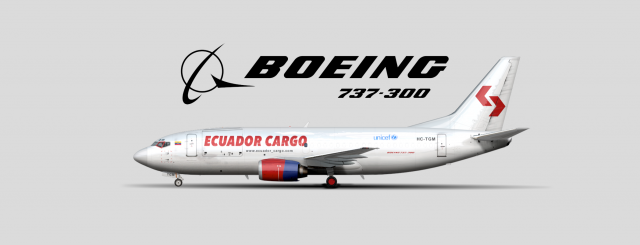737-300 (SF)
- Owner: Fab_Karayou (View all images and albums)
- Uploaded: Mar 28 2023 11:02 AM
- Views: 1,459
- Album Livery #1

The Boeing 737 in its 300 version was integrated into the fleet of Ecuador Cargo in the early 2000s for the oldest. The planes were purchased from companies that operated them for passenger transport. After a passage in the hangars of Turbex Aviation in Nevada to be converted into cargo, the planes were ready for their second life.
The implementation of these planes was quite fast. Indeed, the 737 sector was already familiar with this type of aircraft. For cause, the company already operated several 737-200 also converted into cargo.
The 737-300s were mainly used to serve South and Central America from Quito, the company's main hub, and Guayaquil, a secondary base located west of the River Guayas, which flows into the Pacific Ocean.
Over the years, the 737 sector has developed, offering more rotations and new destinations to serve.
Between the years 2000 and 2012 Ecuador Cargo operated its largest number of 737-300s, with a total of 17 aircraft in service during this period.
Today, the Ecuadorian company continues to operate these aircraft on flights limited to South American countries. Four aircraft of this type are still in operation in 2023.
Diego Vaco is a former pilot of Ecuador Cargo. Born in 1965 in Manta, a coastal city in the province of Manabi, he studied in the capital, where he obtained a degree in literature.
At the age of 18 he joined the Ecuadorian Air Force. First he was a helicopter pilot and then a C-130 helicopter pilot, where he stayed for 8 years.
Before joining Ecuador Cargo in 1994 he flew for various companies after having qualified on 727.
During his career at Ecuador Cargo he flew on 727 ( 1994 - 2001 ) before joining the 737 sector ( 2001 - 2007 ) where he was a captain for four years .
In 2007 he qualified as a 767 pilot and flew more than ten years on this aircraft (2007 - 2020), becoming a captain and then an instructor pilot in 2017.
In 2020, serious health problems prevented him from taking over the controls. Today he holds the positions of chief pilot 767 / 777 and chief sector 767.
Nostalgic of this time when he was flying on 737 he tells us one of his favorite rotation.
Diego: "I loved flying on the 737, especially on the 300 and 400 versions which were practically the same job, with a few exceptions. The 737 is a
very robust and pleasant to fly. It is very simple to operate, which allows to have short stopovers. It is a very good performance aircraft. It has a good payload, it can be positioned on any terrain and is able to take off and land on short runways. It is very interesting. It diversifies the work enormously.
There was one rotation that I particularly liked. The takeoff was from Quito around 01:30 in the morning to Guayaquil. The flight was very fast, half an hour was necessary. To arrive on the spot the stopover was of 35 minutes only. Once the operations were finished, we left directly to Panama City. The landing was planned around 04h00 in the morning. Once there we had a one hour stopover. We met some colleagues from the 727 and 737 sector. The following flight was scheduled, we crossed the pedestrian way to join the colleagues in the prefabs located just in front of the parking points. There was a large common room where pilots of different companies and nationalities gathered. We could rest there, drink, eat... I remember that the Brazilians brought back very good coffee. I was crazy about it ! Some of them read newspapers, played cards, others told each other their aviation stories. A rest room was located just behind. It was equipped with eight bunk beds. But the proximity of the common room made it difficult for some to rest. Some crews had long stopovers. Once this hour passed we left Panama in direction of Havana. 02h30 of flight was necessary. We arrived around 8 am. There, we rested at the hotel during the day to take the controls again the same evening to make the rotation in the opposite direction for an arrival in Quito foreseen at 7:30 a.m. ... with then a return to the house by car rather delicate seen the state of tiredness. "
This Boeing 737 entered service on May 19, 1992 for Piedmont Airlines. It was bought by US Airways in November 1997. In 2003 Ecuador Cargo concluded a deal with US Airways for four 737s. After being converted into cargo, it integrates its new functions on June 02, 2004. It is then registered HC-TGM.
The HC-TGM displays here the old logo and the old colors of the company. The Unicef logo was added in 2012. That year, Ecuador Cargo became an assistant company of this organization on the South American continent.
Today the HC-TGM still has the same paint job.
Concerning the engine, it is usually painted entirely in red. Here, a technical problem on the engine forced the maintenance to replace this part. At this time the only parts available were not yet painted with the company colors.
THANK'S TO AIRPLANO21 FOR THE TEMPLATE

 Sign In
Sign In Create Account
Create Account














Werk Aerosucre